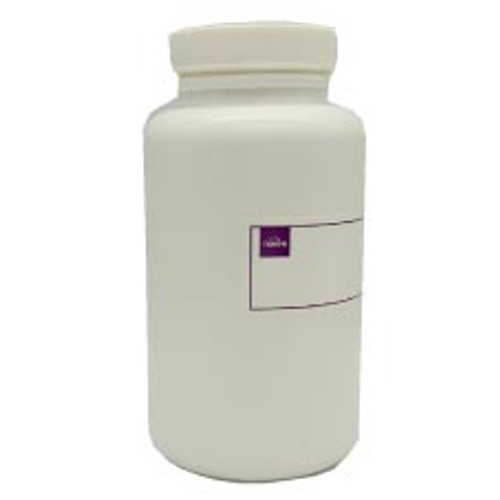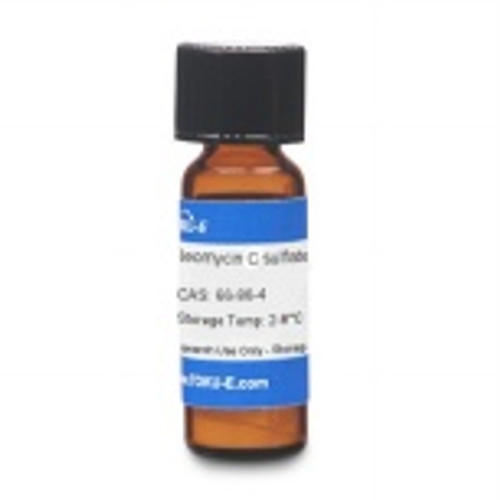Neomycin Sulfate, USP is a broad-spectrum aminoglycoside antibiotic composed of related compounds including Neomycin A (neamine), Neomycin B (framycetin), Neomycin C, and a few minor compounds. Neomycin B is the most active fraction, followed by C and A. The quantities of these components vary from lot to lot.
Neomycin Sulfate, USP conforms to United States Pharmacopoeia specifications.
We also offer:
- Neomycin A Sulfate (Neamine), EvoPure® (N026)
- Neomycin Sulfate, EP (N012)
- Neomycin B Sulfate, EvoPure® (N019)
- Neomycin C Sulfate, EvoPure® (N022)
- Neomycin ReadyMadeTM solution (N027)
Custom manufacturing and testing: We are able to prepare custom Neomycin Sulfate suitable to your unique specifications for use in cell culture, or as ancillary material in upstream biopharma manufacturing. Additionally, we offer additional testing including endotoxin content, arsenic content, cell line testing, spectral analysis, and more. For more information, please contact us.
| Mechanism of Action | Aminoglycosides target the 30S ribosomal subunit resulting in an inability to read mRNA ultimately producing a faulty or nonexistent protein. |
| Spectrum | Neomycin is broad-spectrum, but is mostly used against Gram-negative bacteria. |
| Microbiology Applications | Neomycin can be used for gene selection, via exploiting the resistance gene (NPT II) (Aragão, 2009).
Neomycin is commonly used in clinical in vitro microbiological antimicrobial susceptibility tests (panels, discs, and MIC strips) against Gram-positive and Gram-negative microbial isolates. Medical microbiologists use AST results to recommend antibiotic treatment options. Representative effective ranges include:
For a representative list of Neomycin MIC values, click here. Neomycin Sulfate can also be used for food testing in TSN agar to select for Clostridium perfringins and inhibit growth of Enterobacteria and Clostridium bifermentans. |
| Plant Biology Applications |
Neomycin is commonly used in gene selection wtih Agrobacterium transformation protocols to select for plants that have taken up the plasmid conferring resistance to Neomycin. |
| Eukaryotic Cell Culture Applications |
Neomycin is routinely used to select for cells containing resistance plasmids such as pcDNA3 in cell lines including AtT-20. For additional information, please visit our cell culture database. |
| Molecular Formula | C23H46N6O13 · 3 H2SO4 |
| References |
Neomycin Sulfate (TOKU-E) was used by Fox et al (2013) to study its synergistic effects with blue light irradiation against S. aureus as a biofilm disruptor in antimicrobial photodynamic therapy in: Investigating inhibitory synergy between blue light irradiation and antibiotic treatment of Staphylococcus aureus Aragão FJL and Brasileiro ACM (2002) Positive, negative and marker-free strategies for transgenic plant selection. Braz. J. Plant Physiol. 14(1):1-10 Dai et al (2001) Comparative analysis of transgenic rice plants obtained by Agrobacterium-mediated transformation and particle bombardment. Mol. Breeding 7: 25–33:2001 Davis BD (1987) Mechanism of bactericidal action of aminoglycosides. Microbiol. Rev. 51(3):341-50 Robertson JH (1971) Antimicrobial activity of Neomycin C against Staphylococcus epidermidis. App. Micro. 22(6):1164-1165 Tsuji K and Robertson JH (1969) Comparative study of responses to Neomycins B and C by microbiological and gas-liquid chromatographic assay methods. App. Microbiol. 18(3):396-398 Yuan L and Wei H (2006) Rapid analysis of native Neomycin components on a portable capillary electrophoresis system with potential gradient detection. Analytic. Bioanalyt. Chem. 385(8):1575-1579 |
| MIC | Bacillus subtilis| 0.25|| Enterobacter cloacae| >16|| Erwinia carotovora| 4|| Escherichia coli| 1|| Proteus vulgaris| 0.25|| Pseudomonas aeruginosa| >16|| Pseudomonas solanacearum | 2|| Staphylococcus aureus| 0.25|| Xanthomonas axonopodis| >16|| Xanthomonas oryzae| >16|| |








